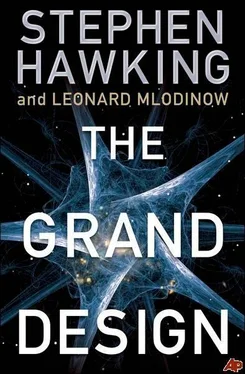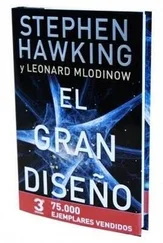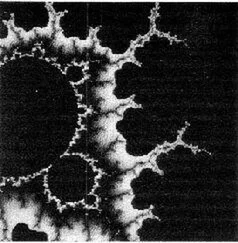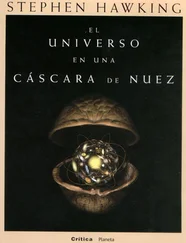Astronomers have also found other fingerprints supporting the big bang picture of a hot, tiny early universe. For example, during the first minute or so, the universe would have been hotter than the center of a typical star. During that period the entire universe would have acted as a nuclear fusion reactor. The reactions would have ceased when the universe expanded and cooled sufficiently, but the theory predicts that this should have left a universe composed mainly of hydrogen, but also about 23 percent helium, with traces of lithium (all heavier elements were made later, inside stars). The calculation is in good accordance with the amounts of helium, hydrogen, and lithium we observe.
Measurements of helium abundance and the CMBR provided convincing evidence in favor of the big bang picture of the very early universe, but although one can think of the big bang picture as a valid description of early times, it is wrong to take the big bang literally, that is, to think of Einstein’s theory as providing a true picture of the origin of the universe. That is because general relativity predicts there to be a point in time at which the temperature, density, and curvature of the universe are all infinite, a situation mathematicians call a singularity. To a physicist this means that Einstein’s theory breaks down at that point and therefore cannot be used to predict how the universe began, only how it evolved afterward. So although we can employ the equations of general relativity and our observations of the heavens to learn about the universe at a very young age, it is not correct to carry the big bang picture all the way back to the beginning.
We will get to the issue of the origin of the universe shortly, but first a few words about the first phase of the expansion. Physicists call it inflation. Unless you’ve lived in Zimbabwe, where currency inflation recently exceeded 200,000,000 percent, the term may not sound very explosive. But according to even conservative estimates, during this cosmological inflation, the universe expanded by a factor of 1,000,000,000,000,000,000,000,000,000,000 in.00000000000000000000000000000000001 second. It was as if a coin 1 centimeter in diameter suddenly blew up to ten million times the width of the Milky Way. That may seem to violate relativity, which dictates that nothing can move faster than light, but that speed limit does not apply to the expansion of space itself.
The idea that such an episode of inflation might have occurred was first proposed in 1980, based on considerations that go beyond Einstein’s theory of general relativity and take into account aspects of quantum theory. Since we don’t have a complete quantum theory of gravity, the details are still being worked out, and physicists aren’t sure exactly how inflation happened. But according to the theory, the expansion caused by inflation would not be completely uniform, as predicted by the traditional big bang picture. These irregularities would produce minuscule variations in the temperature of the CMBR in different directions. The variations are too small to have been observed in the 1960s, but they were first discovered in 1992 by NASA’s COBE satellite, and later measured by its successor, the WMAP satellite, launched in 2001. As a result, we are now confident that inflation really did happen.
Ironically, though tiny variations in the CMBR are evidence for inflation, one reason inflation is an important concept is the nearly perfect uniformity of the temperature of the CMBR. If you make one part of an object hotter than its surroundings and then wait, the hot spot will grow cooler and its surroundings warmer until the temperature of the object is uniform. Similarly, one would expect the universe to eventually have a uniform temperature. But this process takes time, and if inflation hadn’t occurred, there wouldn’t have been enough time in the history of the universe for heat at widely separated regions to equalize, assuming that the speed of such heat transfer is limited by the speed of light. A period of very rapid expansion (much faster than light speed) remedies that because there would have been enough time for the equalization to happen in the extremely tiny preinflationary early universe.
Inflation explains the bang in the big bang, at least in the sense that the expansion it represents was far more extreme than the expansion predicted by the traditional big bang theory of general relativity during the time interval in which inflation occurred. The problem is, for our theoretical models of inflation to work, the initial state of the universe had to be set up in a very special and highly improbable way. Thus traditional inflation theory resolves one set of issues but creates another-the need for a very special initial state. That time-zero issue is eliminated in the theory of the creation of the universe we are about to describe.
Since we cannot describe creation employing Einstein’s theory of general relativity, if we want to describe the origin of the universe, general relativity has to be replaced by a more complete theory. One would expect to need a more complete theory even if general relativity did not break down, because general relativity does not take into account the small-scale structure of matter, which is governed by quantum theory. We mentioned in Chapter 4 that for most practical purposes quantum theory does not hold much relevance for the study of the large-scale structure of the universe because quantum theory applies to the description of nature on microscopic scales. But if you go far enough back in time, the universe was as small as the Planck size, a billion-trillion-trillionth of a centimeter, which is the scale at which quantum theory does have to be taken into account. So though we don’t yet have a complete quantum theory of gravity, we do know that the origin of the universe was a quantum event. As a result, just as we combined quantum theory and general relativity-at least provisionally-to derive the theory of inflation, if we want to go back even further and understand the origin of the universe, we must combine what we know about general relativity with quantum theory.
To see how this works, we need to understand the principle that gravity warps space and time. Warpage of space is easier to visualize than warpage of time. Imagine that the universe is the surface of a flat billiard table. The table’s surface is a flat space, at least in two dimensions. If you roll a ball on the table it will travel in a straight line. But if the table becomes warped or dented in places, as in the illustration below, then the ball will curve.
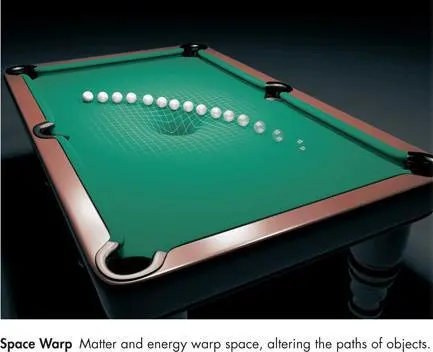
It is easy to see how the billiard table is warped in this example because it is curving into an outside third dimension, which we can see. Since we can’t step outside our own space-time to view its warpage, the space-time warpage in our universe is harder to imagine. But curvature can be detected even if you cannot step out and view it from the perspective of a larger space. It can be detected from within the space itself. Imagine a micro-ant confined to the surface of the table. Even without the ability to leave the table, the ant could detect the warpage by carefully charting distances. For example, the distance around a circle in flat space is always a bit more than three times the distance across its diameter (the actual multiple is π). But if the ant cut across a circle encompassing the well in the table pictured above, it would find that the distance across is greater than expected, greater than one-third the distance around it. In fact, if the well were deep enough, the ant would find that the distance around the circle is shorter than the distance across it. The same is true of warpage in our universe-it stretches or compresses the distance between points of space, changing its geometry, or shape, in a way that is measurable from within the universe. Warpage of time stretches or compresses time intervals in an analogous manner.
Читать дальше
